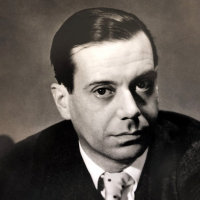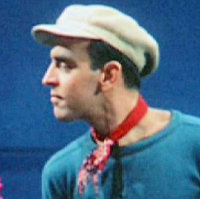| Handout (flat) Handout (folded) Class Script | Return to Index |
Q AND A
What was the original inspiration for Kiss Me, Kate?
Apparently the show is based upon the stormy relationship of Thirties stars Alfred Lunt and Lynn Fontanne. But it is not a mere
roman à clef. The situation of a middle-aged actress leaving the stage for Hollywood but longing to return to the live
theater gives a recognizable poignancy to Lilli Vanessi that doesn't need any specific identification.
What is the origin of the physical maltreatment in the play?
I discovered just now that the tradition of giving Petruchio a whip and at one stage having him spank Kate comes from a 1754
adaptation of the Shakespeare play by David Garrick, which was hugely popular and virtually the only version seen on American
stages for the next century and a half. You can read more on
Wikipedia.
How can you handle the spanking scene in the #MeToo era?
Basically, you can't, as several people pointed out in today's class. The 1999 Blakemore production keeps it in; it takes place
about halfway through the relevant clip, but she gives almost as good as
she gets, and they bring the curtain in s soon as the actual spanking starts. In the 2019 Roundabout Theatre revival, they both
hit each other, though in less sexually-charged ways, and he ends as bruised as her; see further
here.
What went wrong at the end of today's class?
It appears that I accidentally touched the "R" key on the computer, which, in the program I use to project my clips, triggers
a Random function that plays the items in an arbitrary order. I now know how to rescue it (hit "R" again), but didn't
then; thanks for your patience. We did lose the ending of the show in the film version, where Kate's lines are spoken; alas it
is no longer available on YouTube. I also enourage you to look at the various versions of the ending of the play I posted
below.
VIDEO LINKS
When I prepared this class a few weeks ago, all three versions of the show that we sampled in class were available complete on YouTube. This is still the case with the 2015 Proms performance, but the other two are problematical. The 1953 movie is no longer free, though it can be rented for about $4; I include links below to the trailer and a couple of other scenes we watched in class, plus the notorious spanking scene. The 1999 Blakemore production is free, but in the form of a playlist in 22 sections, which do not often align with the musical numbers; it also has terribly obtrusive subtitles. Go to these links if you prefer to buy it (about $10) or rent it through Amazon Prime.
In the final section, you will find links to excerpts from other sources, plus four different versions of Kate's final monologue in the Shakespeare—one of which is rewritten in modern English, and another imagines a female Petruchia in a matriarchal society. Scratch your head, if you must, but enjoy. rb.
| PRODUCTIONS SHOWN IN CLASS | |||
| Movie, 1953 |
Trailer Spanking scene Brush up your Shakespeare From this Moment On |
||
| Blakemore, 1999 |
Opening
(playlist in 22 sections!) — Wunderbar — So in Love — Act I finale, opening — Act I finale, end, and Act II opening — Remainder of "Too darn hot" — Harrison Howell dialogue — Harrison Howell song — Brush up your Shakespeare — Ending |
||
| London Proms, 2015 | Opening (complete show) | ||
| ADDITIONAL ITEMS | |||
| Hallmark Hall of Fame, 1959 | Complete (though shortened) (B&W, with the original two leads) | ||
| Broadway, 2019 | Trailer (a rather different esthetic) | ||
| London, 2024 | "Too darn hot" | ||
| Kate's final speech |
Elizabeth Taylor
(Zeffirelli movie) Thalissa Teixeira, Globe 2024 Shirley Henderson, Shakespeare Retold (in modern prose) Joseph Arkley, RSC 2019 (with genders reversed!) |
||


















